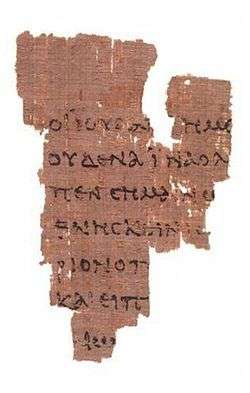John 18
| John 18 | |
|---|---|
|
John 18:31-33 on John Rylands Library Papyrus P52 (recto), written ca. AD 125. | |
| Book | Gospel of John |
| Bible part | New Testament |
| Order in the Bible part | 4 |
| Category | Gospel |
John 18 is the eighteenth chapter of the Gospel of John in the New Testament of the Christian Bible. It records the events on the day of the crucifixion of Jesus Christ, starting with His arrest.[1] The book containing this chapter is anonymous, but early Christian tradition uniformly affirmed that John composed this Gospel.[2]
Text
- The original text is written in Koine Greek.
- Some most ancient manuscripts containing this chapter are:
- Rylands Library Papyrus P52 (ca. AD 125; extant: verses 31-33, 37-38)
- Papyrus 90 (AD 150-175; extant: verses 36-40)
- Papyrus 108 (2nd/3rd century; extant: verses 1-5)
- Papyrus 66 (ca. AD 200; complete)
- Codex Vaticanus (AD 325-350)
- Codex Sinaiticus (AD 330-360)
- Codex Bezae (ca. AD 400)
- Codex Alexandrinus (AD 400-440)
- Codex Ephraemi Rescriptus (ca. AD 450; extant: verses 1-35)
- Papyrus 60 (ca. AD 700; complete).
- Papyrus 59 (7th century; extant: verses 1-2, 16-17, 22).
- This chapter is divided into 40 verses.
Places
Events recorded in this chapter took place in Jerusalem.
Structure
The New King James Version organises this chapter as follows:
- John 18:1-11 = Betrayal and Arrest in Gethsemane (Matthew 26:47-56; Mark 14:43-50; Luke 22:47-53)
- John 18:12-14 = Before the High Priest (Matthew 26:57)
- John 18:15-18 = Peter Denies Jesus (Matthew 26:69,70; Mark 14:66-68; Luke 22:55-57)
- John 18:19-24 = Jesus Questioned by the High Priest (Matthew 26:59-68; Mark 14:55-65; Luke 22:63-71)
- John 18:25-27 = Peter Denies Twice More (Matthew 26:71-75; Mark 14:69-72; Luke 22:58-62)
- John 18:28-38 = In Pilate’s Court (Matthew 27:1-2,11-14; Mark 15:1-5; Luke 23:1-5)
- John 18:39-40 = Taking the Place of Barabbas (continued until chapter 19:16; Matthew 27:15-31; Mark 15:6-20; Luke 23:13-25)
Jesus' betrayal and arrest in Gethsemane
The opening of chapter 18 is connected directly with the final words of chapter 14:
- Arise, let us go from here (John 14:31).
John 18:1 begins:
- When Jesus had spoken these words, He went out with His disciples over the Brook (or winter stream) Kidron, where there was a garden, which He and His disciples entered. And Judas, who betrayed Him, also knew the place; for Jesus often met there with His disciples (John 18:1-8, New King James Version).
Some translations instead open with "When He had finished praying" or similar words.[3]
Matthew 26:36 and Mark 14:32 name the garden as "Gethsemane" but the garden is unnamed here.
Judas is now called "Judas the betrayer" or "Judas, who is betraying" (Greek: ιουδας ο παραδιδους, ioudas ho paradidous) (John 18:2 and again in verse 5).[4] He comes to this familiar place with troops, a captain and officers and servants of the chief priests and the Pharisees, carrying torches and lanterns and weapons (verse 6, cf. verse 12). Anglican bishop Charles Ellicott surmises that Gethsemane might have been belonged to "a friend or disciple" of Jesus.[5] The New American Standard Bible notes that the troops were the Roman cohort (Greek: σπεῖρα, speira in John 18:3 is the technical word for the Roman cohort) [6] whereas Richard Francis Weymouth identified them as a detachment of the Temple police.[7] This was the garrison band from Fort Antonia, at the north-east corner of the Temple. Peter also came with a weapon (verses 10-11):
- Then Simon Peter, having a sword, drew it and struck the high priest’s servant, and cut off his right ear. The servant’s name was Malchus.[8]
What is truth?
- Pilate said to Him, “What is truth?” And when he had said this, he went out again to the Jews, and said to them, “I find no fault in Him at all.[9]
See also
- Arrest of Jesus
- Barabbas
- Denial of Peter
- Jerusalem
- Jesus Christ
- Pontius Pilate
- Rylands Library Papyrus P52
- Sanhedrin trial of Jesus
- Other related Bible parts: Matthew 26, Matthew 27, Mark 14, Mark 15, Luke 22, Luke 23, John 13, John 19
References
- ↑ Halley, Henry H. Halley's Bible Handbook: an abbreviated Bible commentary. 23rd edition. Zondervan Publishing House. 1962.
- ↑ Holman Illustrated Bible Handbook. Holman Bible Publishers, Nashville, Tennessee. 2012.
- ↑ e.g. New International Version, International Children's Bible and Weymouth New Testament
- ↑ Vincent's Word Studies on John 18, accessed 12 July 2016
- ↑ Ellicott's Commentary for English Readers on John 18, accessed 16 July 2016
- ↑ Ellicott's Commentary for English Readers on John 18, accessed 16 July 2016
- ↑ Weymouth New Testament, John 18:3
- ↑ John 18:10
- ↑ John 18:38
External links
| Preceded by John 17 |
Chapters of the Bible Gospel of John |
Succeeded by John 19 |
